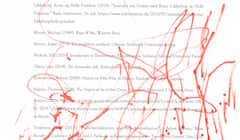A Didactics of Cultural Readings
DOI:
https://doi.org/10.20343/teachlearninqu.11.22Keywords:
cultural reading, close reading, transparent performance expectations, imitation, literary studiesAbstract
This article makes a case for the effectiveness of using imitation-style teaching as a way to introduce how to write theoretically informed pieces of literary or media criticism to undergraduates. By making a case for the relevance of teaching this form of criticism in the undergraduate classroom, as well as exploring exactly how imitation-style teaching can be used to teach this skill, this article argues that teachers can fruitfully study closely with students pieces of literary criticism in the undergraduate classroom. The article argues that this teaching practice is able to live up to the idea of “transparent performance expectations,” one of didactician Hilbert Meyer’s 10 central criteria for good teaching.
Click here to read the corresponding ISSOTL blog post.
References
Ardizzone, Tony, Fritz Breithaupt, og Paul C. Gutjahr. 2004. “Decoding the Humanities.” New Directions in Teaching and Learning 98: 45–56.
Augé, Marc. 1995. Non-Places: Introduction to an Anthropology of Supermodernity. London: Verso.
Bass, Randy, and Sherry Lee Linkon. 2008. “On the Evidence of Theory: Close Reading as a Disciplinary Model for Writing about Teaching and Learning.” Arts & Humanities in Higher Education 7 (3): 245–61.
Byrge, Christian, and Søren Hansen. 2015. The Creative Platform: A Handbook in Creative Processes for Education and Worklife. Frederiksberg: Frydenlund.
Christiansen, Steen Ledet. 2004. “Of Questions and Positions, or What Does it Mean to Theorize Media?” In Culture, Media, Theory, Practice Perspectives, edited by Ben Dorfman, 225–33. Aalborg, DK: Aalborg University Press.
Coupland, Douglas. 1991. Generation X: Tales for an Accelerated Culture. London: St. Martin’s Press.
Dudziak, Mary. 2011. Cold War Civil Rights. Princeton: Princeton University Press.
Felski, Rita. 2008. Uses of Literature. Oxford: Blackwell Publishing.
Gray, Richard. 2004. A History of American Literature. Oxford: Blackwell Publishing.
Hegelund, Signe, and Kock, Christian. 2003. “A Good Paper Makes a Case: Teaching Academic Writing the Macro-Toulmin Way.” In Teaching Academic Writing in European Higher Education, edited by Lennart Björk, Gerd Bräuer, Lotte Rienecker, and Peter Stray Jörgensen, 75–85. Dordrecht, NE: Kluwer Academic Publishers.
Hoggart, Richard. 1970. Speaking to Each Other: About Literature, vol. 2. London, UK: Chatto & Windus.
Hughes, Langston. (1926) 2001. “Epilogue.” In The Collected Works of Langston Hughes: The poems, 1921-1940, edited by Arnold Rampersad, 61–2. London, UK: University of Missouri Press.
Jongh, James de. 2004. “The Poet Speaks of Places: A Close Reading of Langston Hughes’s Use of Place.” In A Historical Guide to Langston Hughes, edited by Steven C. Tracy, 65–84. New York: Oxford University Press.
Kelleter, Frank. 2014. Serial Agencies: The Wire and Its Readers. Hants, UK: Zero Books.
Kock, Christian, and Merete Onsberg. 2009. “Retorisk Tekstproduktion.” In Retorik: Teori og Praksis, edited by Charlotte Jørgensen and Lisa Villadsen, 251–62. Frederiksberg: Samfundslitteratur.
Kock, Christian. 1998. “At Undervise i at Skrive.” In At undervise i Humaniora, edited by Tone Saugstad Gabrielsen and Per Fibæk Laursen, 64–82. Frederiksberg: Samfundslitteratur.
Kock, Christian. 2006. “Læsning som Grundlag for Skriftlighed.” Anglo Files 139: 69–72.
Kock, Christian. 2013. Retorisk Praksis. Ödåkra, SE: Retorikforlaget.
Lavik, Erlend. 2014. Tv-Serier: The Wire og den Tredje Gullalderen. Oslo: Universitetsforlaget.
MacPherson, Kristina Ruth. 2015. “Decoding Area Studies and Interdisciplinary Majors: Building a Framework for Entry-Level Students.” College Teaching 63 (2): 40–45.
Metzger, Christiane, and Andrea Brose. 2020. “‘Decoding’ from the Perspective of Higher Education Didactics.” Didaktik-Nachrichten: 9–10. https://diz-bayern.de/DiNa/07_2020.
Meyer, Hilbert. 2005. Hvad er god Undervisning? Translated by Peter Dürrfeld. Copenhagen: Hans Reitzels Forlag.
Nakamura, Jeanne, and Mihaly Csikszentmihalyi. 2009. “The Concept of Flow.” In Oxford Handbook of Positive Psychology, edited by Shane J. Lopez and C.R. Snyder, 89–105. Oxford: Oxford University Press.
Pace, David. 2017. The Decoding the Disciplines Paradigm. Bloomington: Indiana University Press.
Pace, David. 2021. “Beyond Decoding the Disciplines 1.0: New Directions for the Paradigm.” Teaching & Learning Inquiry 9 (2).
Pease, Donald E. 2011. “Introduction: Re-Mapping the Transnational Turn.” In Re-Framing the Transnational Turn in American Studies, edited by Winfried Fluck, Donald E. Pease, John Carlos Rowe, 1–46. Hanover: Dartmouth College Press.
Rampersad, Arnold, and Roessell, David. 1995. “Introduction.” In The Collected Works of Langston Hughes, edited by Arnold Rampersad and David Roessell, 3–7. New York: Vintage Classics.
Riegler, Peter. 2020. “Decoding the Disciplines – A Roundtrip from Novice to Expert back to Novice.” DidaktikNachrichten, 3–8. https://diz-bayern.de/DiNa/07_2020.
Ritterhouse, Jennifer. 2006. Growing Up Jim Crow: How Black and White Southern Children Learned Race. Chapel Hill, NC: The University of North Carolina Press.
Sløk, Johannes. 2008. Gud, Menneske, Kosmos – om Idéhistorie. Copenhagen: Gyldendal.
Sørensen, Bent. 2015. “From Hell or From Nowhere? Non-Places in Douglas Coupland’s Novels.” In Non-Place: Representing Placelessness in Literature, Media and Culture, edited by Mirjam Gebauer, Helle Thorsøe Nielsen, Jan Tödtloff Schlosser, and Bent Sørensen, 95–112. Aalborg, DK: Aalborg University Press. Accessed 1 August 2022.
Sørensen, Nils Arne. 2009. “Den Transnationale Vending?” Historisk Tidsskrift 109(2): 459–72. Accessed 1 August 2022.
Thorup, Mikkel. 2013. “Taget ud af Sammenhæng – om Kontekst i Idéhistorie.” Slagmark 67: 77–108. Accessed 1 August 2022.
Tyson, Lois. 2006. Critical Theory Today, second edition. London: Routledge.

Downloads
Published
Issue
Section
License
Copyright (c) 2023 Mikkel Jensen

This work is licensed under a Creative Commons Attribution-NonCommercial 4.0 International License.


